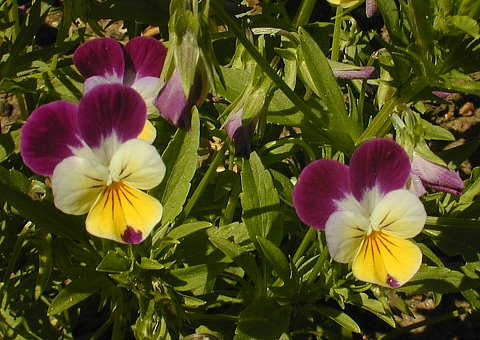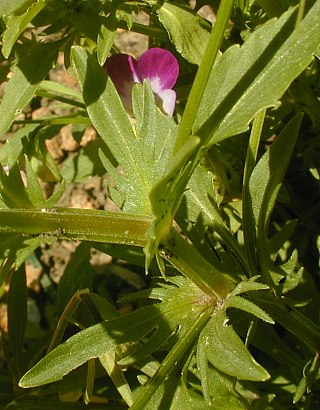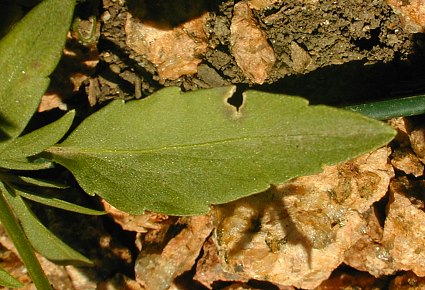
Occasionally, individual flowers are produced from the leaf axils on long ascending pedicels with nodding tips. The pedicels are light green to purplish green and glabrous. Each flower is ¾-1¼" across, consisting of 5 widely spreading petals, 5 sepals, a pistil with a swollen stigma, and 5 inserted stamens. The typical flower has violet or purple upper petals, white lateral petals, and a yellow lower petal, but other color variations are possible. Several purple veins originate from the throat of the flower. The lateral petals have small tufts of white hair at their bases, while the lower petal terminates in a nectar spur that is short and blunt. The sepals are medium green or purplish green, glabrous, lanceolate, and about ¼" long; they are much shorter than the petals. The blooming period occurs from late spring to mid-summer for about 1-2 months; sometimes the flowers will bloom later in the summer or autumn. The flowers are usually fragrant. Fertile flowers are replaced by seed capsules about ½" long that are ovoid-oblongoid in shape and glabrous. At maturity, each seed capsule divides into 3 segments, ejecting the seeds. The root system is shallow and fibrous.

Cultivation: The preference is full or partial sun, moist to mesic conditions, cool to warm summer temperatures, and soil that is loamy, gravelly, or sandy. There is a tendency for this plant to spontaneously reseed itself, although it is not particularly aggressive.
Range & Habitat: In Illinois, naturalized populations of Johnny Jump-Up are uncommon; so far it has been found primarily in the NE section of the state (see Distribution Map). Johnny Jump-Up was introduced into the United States from Europe as an ornamental plant. As a naturalized plant, it is typically encountered in such habitats as uncultivated areas of gardens, gravelly areas along the foundations of buildings, vacant lots, nursery plots, and waste areas with sparse vegetation. Areas with a history of disturbance are strongly preferred. Johnny Jump-Up is widely cultivated in flower gardens.
Faunal Associations: In Germany, Müller (1873/1883) observed honeybees, bumblebees, a long-tongued bee (Anthophora sp.), a Syrphid fly (Rhingia sp.), and butterflies visiting the flowers of Johnny Jump-Up for nectar. Another Syrphid fly, Syritta pipiens, fed on pollen and was probably non-pollinating. Other insects feed on the foliage, plant juices, etc., of Johnny Jump-Up and other violets (Viola spp.). These insects feeders include the caterpillars of Euptoieta claudia (Variegated Fritillary) and other Fritillary butterflies (Boloria spp., Speyeria spp.); caterpillars of the moths Apantesis nais (Nais Tiger Moth), Archips purpurana (Omnivorous Leafroller), Elaphria grata (Grateful Midget), Eubaphe mendica (The Beggar), Hypercompe scribonia (Giant Leopard Moth), Spodoptera dolichos (Dolichos Armyworm), and Xestia smithii (Smith's Dart); larvae of Ametastegia pallipes (Violet Sawfly); the larvae of Prodiplosis violicola (Violet Gall Midge); the aphids Myzus persicae and Neotoxoptera violae; and the thrips Odontothrips pictipennis (for more information, see Bouseman & Sternberg, 2001; Covell, 1984/2005; Wagner, 2005; Cranshaw, 2004; Eastman, 1992; Hottes & Frison, 1931; and Stannard, 1968). The value of violets to vertebrate animals is relatively minor. The seeds are eaten by such birds as the Mourning Dove, Slate-Colored Junco, Bobwhite, Wild Turkey, and Ruffed Grouse (Martin et al., 1951/1961; Lewis, 1993), while the foliage is browsed occasionally by the Cottontail Rabbit.

Photographic Location: An herbal garden at Meadowbrook Park in Urbana, Illinois.
Comments: Another common name of Viola tricolor is Wild Pansy. Johnny Jump-Up is one of the parent species of the modern pansy, Viola × wittrockiana, which has larger flowers (1½" across or more). There are many cultivated forms of Johnny Jump-Up that have differently colored flowers of variable size. Some of these cultivars display characteristics that suggest hybridization with another introduced species, Viola bicolor (Field Pansy). In general, Johnny Jump-Up is a more robust plant with tricolored flowers, while Field Pansy has bicolored flowers that are smaller (about ½" across). This latter species also occurs in Illinois.